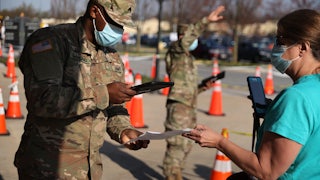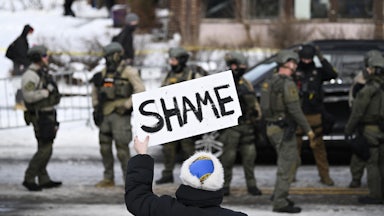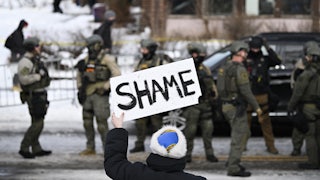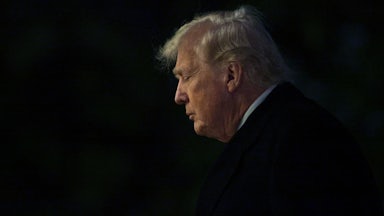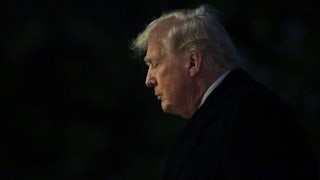The dust had seemed to settle on questions of school reopenings—one of the most polarizing political debates of the pandemic. In the spring of 2021, as vaccine shots were administered into arms, and with Congress having authorized billions of new funds for K-12 budgets, it seemed that, for the first time, parents, teachers, and staff could breathe a bit easier. Hope was here, and safe in-person learning was in reach.
Yes, millions of students had opted to stay remote in the spring even when their schools reopened (many parents reported that their child was doing well with virtual school, that it was safer than in-person, or a combination of the two), but leaders were optimistic about autumn, where real normalcy was on the horizon. Some politicians, like New York City Mayor Bill de Blasio, even came out early to proclaim there would be no virtual option in the fall—a decision some cheered for its confident signal that the end was near.
Yet recent weeks have reintroduced uncertainty, with the delta coronavirus variant; conflicting guidelines on the local, state, and federal levels; and warring politics that seem to escalate by the day. For the millions of students who have already returned to school, and for those still waiting for the school year to start, signs unfortunately now point to continued chaos with quarantines, closures, and fast-changing rules. In other words, we’re looking at a new school year that could look a lot like last year. To make sense of all, here’s an accounting of where things stand, what we know, and what we have yet to learn.
By mid-May, the CDC announced new masking guidelines, emphasizing that fully vaccinated people no longer needed face coverings outdoors and in most indoor settings. The guidelines took many by surprise, and it wasn’t clear how institutions would determine who was vaccinated or not. But such details were largely waved aside. “We have all longed for this moment,” Dr. Rochelle Walensky, the CDC director, said at a press conference.
By early July, the CDC went further, releasing new guidance for schools that said while young children should wear masks, vaccinated teachers and students can learn safely in school buildings without them. The agency recommended three feet of distance where possible, but said if that was infeasible it need not stop a return to in-person learning.
At the time of the new schools guidance, Covid-19 cases were fairly low, and the majority of educators had been at least partially vaccinated. President Biden missed his goal of 70 percent of American adults having a shot in their arms by Independence Day, but his administration said not to worry, that there still had been amazing progress. Yet it was hard to ignore that vaccination rates had slowed nationally, and a new, more transmissible variant loomed.
Nearly three weeks later, the mood around the pandemic was far less sanguine, as cases, hospitalizations, and deaths were spiking. Some companies began to push back their return-to-office start days out of an abundance of caution, but there was no similar move to delay school reopenings. Even as some business executives decided it was not yet safe for workers to return, political leaders continued to emphasize that returning to classrooms in August or September would be fine. They pointed to studies from earlier in the pandemic, while acknowledging that the delta variant may complicate those findings. Few were ready to consider any alternative.
On July 27, citing new research on delta, the CDC issued new school guidance, recommending that all students and staff—even if fully vaccinated—wear masks. Only 30 percent of young people ages 12–17 were then fully vaccinated, said Walensky, and the CDC’s data suggested even vaccinated individuals were spreading the virus.
Still, the CDC’s new warnings came at a time when millions of Americans had lost confidence in the agency’s leadership, and many conservatives saw railing at the CDC as good politics to boot.
On July 29, Texas Governor Greg Abbott issued an executive order barring local governments and school districts from requiring masks. Not to be outdone, the next day Florida Governor Ron DeSantis issued his own executive order forbidding schools from requiring students to wear masks, going so far as to say it was a matter of “parent rights.” His order, which hinges on one study from Brown University, dismissed the larger body of research showing masks significantly reduce the risk of Covid spread. DeSantis also said Florida would deny funding to districts that defied him.
Some school districts are indeed defying state bans on masks, and the Biden administration has said it will look to support superintendents who risk retribution. Still, according to data collected by the Center on Reinventing Public Education at the University of Washington Bothell, currently about half of the nation’s 100 largest school districts are requiring students to wear masks this fall. As of Thursday, just seven were requiring regular testing of both students and staff.
Vaccinations are adding yet another layer of complication to school reopenings. After months of encouraging voluntary inoculation, the federal government, private employers, and school districts are now moving slowly toward requiring all employees to be vaccinated. Last week, California became the first state to announce that all teachers, school staff, and even parent volunteers would need vaccination. Chicago Public Schools, the nation’s third-largest district, announced Friday that all staff must be vaccinated—a move also endorsed by its local teachers union.
In late July it seemed unclear whether unions would stand in the way of more aggressive vaccination rules, given their reluctance to overriding collective bargaining agreements. When Biden announced on July 29 his new rule that federal workers be vaccinated or regularly tested, some unions, including the left-leaning American Postal Workers Union, expressed opposition to the top-down dictates.
But public opinion remains strong behind teacher vaccinations, and union leaders quickly came around. (Among parents with school-age children, 60 percent say they think all teachers should be vaccinated before returning to the classroom.) On August 8, Randi Weingarten, president of the American Federation of Teachers, came out in favor of Covid-19 vaccine requirements. “As a matter of personal conscience, I think that we need to be working with our employers, not opposing them, on vaccine mandates,” she said on Meet the Press. Four days later, Becky Pringle, the president of the National Education Association, came out in favor of vaccine mandates. Individual local unions have also started to pass resolutions in support.
But student uptake remains spotty among those eligible for the vaccine. As of August 11, in six states, over 60 percent of children ages 12–17 had received at least one dose, while in seven states, 30 percent or fewer had gotten their first shot. Yet many school districts have decided not to require students to inoculate themselves against Covid-19, despite long requiring student immunizations for other diseases.
In Washington D.C., for example, just 14 percent of Black youth ages 12–15 had received one dose of the vaccine as of August 4, as compared with 51 percent of white students in the same age group. Among 16- and 17-year-olds in the district, just 21 percent of Black students had been vaccinated, while 47 percent of white students had. City leaders say they worry a new mandate for students could inspire backlash, and instead want to incentivize voluntary shots. Mayor Muriel Bowser recently announced the district would distribute up to 1,200 free AirPods to teens who got vaccinated, as well as award college scholarships to vaccinated students in a raffle.
After months of stressing that children are not at risk of severe Covid-19 or death, and that the vaccines are good at preventing severe Covid-19 and death, leaders should not be too surprised that some families are hesitant to conclude that vaccinating their kids is worth it. Still, with low youth vaccination rates and the delta strain being more than twice as contagious as previous variants, pediatric cases and hospitalizations have been increasing, and more experts are warning about the risks to children of so-called long Covid.
New research about the potentially waning efficacy of the vaccines is throwing yet another wrench into school reopenings. Experts are seeing much more spread among vaccinated individuals, and one preprint study published last week by the Mayo Clinic suggested the mRNA vaccines may be significantly less effective in protecting against delta infection—as low as 42 percent effectiveness for those inoculated with the Pfizer vaccine.
On Friday, the FDA approved booster shots for certain immunocompromised individuals, a positive step, but many children live with adults who are immunocompromised and not yet eligible for third doses. While parents worry about the health and safety of their children, they’re also weighing the health and safety of their own parents, themselves, their siblings, their co-workers, and their neighbors. Some families will want to wait until their young children are eligible for the vaccines, or until more vulnerable groups are eligible for boosters.
It’s not hard to see why. In Mississippi, nearly 1,000 children and 300 school staff tested positive for Covid between August 2 and 6, with roughly 5,000 quarantining from exposure. One Arkansas district had an outbreak of 43 cases, leading more than 800 students and staff to quarantine. In Florida, the Palm Beach County district superintendent reported that two days into the new school year, more than 400 students were in quarantine and the district had 134 confirmed cases, with 108 students and 26 staff members infected.
Given the uncertainty around the delta threat, a growing number of families have called for assurance that their children can learn virtually this fall. Even with experts warning that children risk falling behind academically if they continue to learn remotely, some families believe the harms do not outweigh the benefits in a pandemic, especially when many districts plan to be even more lax about testing and contact tracing than they were in 2020.
According to the Center on Reinventing Public Education, 80 percent of the nation’s 100 largest school districts will now be offering a virtual option; that share doubled in the first two weeks of August alone. However, New York City, the nation’s largest public school district, has not yet agreed to make remote learning available.
Getting kids back into the classroom and easing the burden on working families (especially mothers, who still shoulder most of the child-rearing duties) remain top policy goals, and leaders hope that the new vaccine mandates, the pressure to ramp up mitigation measures, and forthcoming FDA full approval for Covid-19 shots will help limit the spread of the highly contagious strain and ease lingering concerns.
But for those hoping we were finally at the end of the tunnel and could now enjoy calm and relaxed in-person school, the coronavirus has wrought yet another rude awakening.


